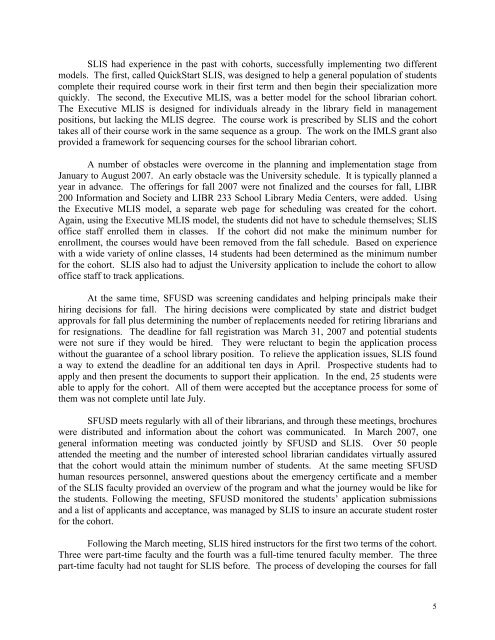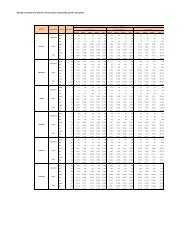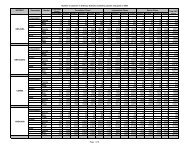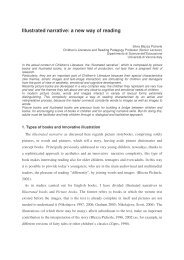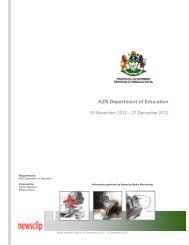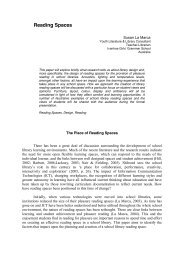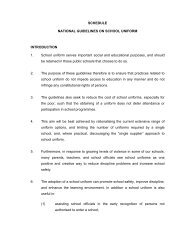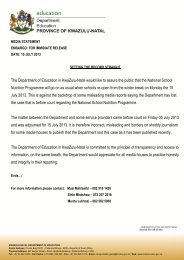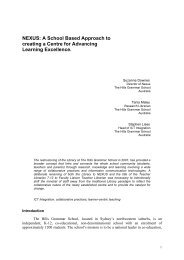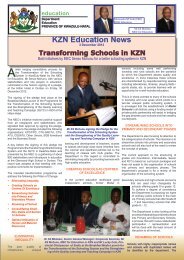Using Technology to Prepare World Class School Librarians to ...
Using Technology to Prepare World Class School Librarians to ...
Using Technology to Prepare World Class School Librarians to ...
You also want an ePaper? Increase the reach of your titles
YUMPU automatically turns print PDFs into web optimized ePapers that Google loves.
SLIS had experience in the past with cohorts, successfully implementing two different<br />
models. The first, called QuickStart SLIS, was designed <strong>to</strong> help a general population of students<br />
complete their required course work in their first term and then begin their specialization more<br />
quickly. The second, the Executive MLIS, was a better model for the school librarian cohort.<br />
The Executive MLIS is designed for individuals already in the library field in management<br />
positions, but lacking the MLIS degree. The course work is prescribed by SLIS and the cohort<br />
takes all of their course work in the same sequence as a group. The work on the IMLS grant also<br />
provided a framework for sequencing courses for the school librarian cohort.<br />
A number of obstacles were overcome in the planning and implementation stage from<br />
January <strong>to</strong> August 2007. An early obstacle was the University schedule. It is typically planned a<br />
year in advance. The offerings for fall 2007 were not finalized and the courses for fall, LIBR<br />
200 Information and Society and LIBR 233 <strong>School</strong> Library Media Centers, were added. <strong>Using</strong><br />
the Executive MLIS model, a separate web page for scheduling was created for the cohort.<br />
Again, using the Executive MLIS model, the students did not have <strong>to</strong> schedule themselves; SLIS<br />
office staff enrolled them in classes. If the cohort did not make the minimum number for<br />
enrollment, the courses would have been removed from the fall schedule. Based on experience<br />
with a wide variety of online classes, 14 students had been determined as the minimum number<br />
for the cohort. SLIS also had <strong>to</strong> adjust the University application <strong>to</strong> include the cohort <strong>to</strong> allow<br />
office staff <strong>to</strong> track applications.<br />
At the same time, SFUSD was screening candidates and helping principals make their<br />
hiring decisions for fall. The hiring decisions were complicated by state and district budget<br />
approvals for fall plus determining the number of replacements needed for retiring librarians and<br />
for resignations. The deadline for fall registration was March 31, 2007 and potential students<br />
were not sure if they would be hired. They were reluctant <strong>to</strong> begin the application process<br />
without the guarantee of a school library position. To relieve the application issues, SLIS found<br />
a way <strong>to</strong> extend the deadline for an additional ten days in April. Prospective students had <strong>to</strong><br />
apply and then present the documents <strong>to</strong> support their application. In the end, 25 students were<br />
able <strong>to</strong> apply for the cohort. All of them were accepted but the acceptance process for some of<br />
them was not complete until late July.<br />
SFUSD meets regularly with all of their librarians, and through these meetings, brochures<br />
were distributed and information about the cohort was communicated. In March 2007, one<br />
general information meeting was conducted jointly by SFUSD and SLIS. Over 50 people<br />
attended the meeting and the number of interested school librarian candidates virtually assured<br />
that the cohort would attain the minimum number of students. At the same meeting SFUSD<br />
human resources personnel, answered questions about the emergency certificate and a member<br />
of the SLIS faculty provided an overview of the program and what the journey would be like for<br />
the students. Following the meeting, SFUSD moni<strong>to</strong>red the students’ application submissions<br />
and a list of applicants and acceptance, was managed by SLIS <strong>to</strong> insure an accurate student roster<br />
for the cohort.<br />
Following the March meeting, SLIS hired instruc<strong>to</strong>rs for the first two terms of the cohort.<br />
Three were part-time faculty and the fourth was a full-time tenured faculty member. The three<br />
part-time faculty had not taught for SLIS before. The process of developing the courses for fall<br />
5


